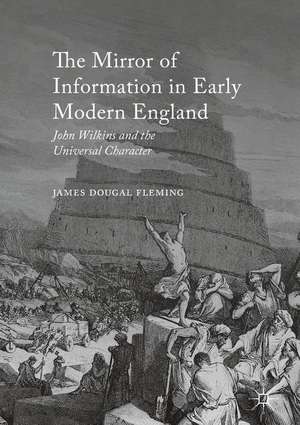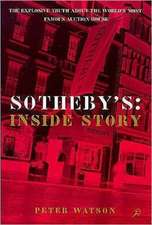The Mirror of Information in Early Modern England: John Wilkins and the Universal Character
Autor James Dougal Flemingen Limba Engleză Hardback – 4 noi 2016
This book examines the seventeenth-century project for a "real" or "universal" character: a scientific and objective code. Focusing on the Essay towards a real character, and a philosophical language (1668) of the polymath John Wilkins, Fleming provides a detailed explanation of how a real character actually was supposed to work. He argues that the period movement should not be understood as a curious episode in the history of language, but as an illuminating avatar of information technology. A non-oral code, supposedly amounting to a script of things, the character was to support scientific discourse through a universal database, in alignment with cosmic truths. In all these ways, J.D. Fleming argues, the world of the character bears phenomenological comparison to the world of modern digital information—what has been called the infosphere.
| Toate formatele și edițiile | Preț | Express |
|---|---|---|
| Paperback (1) | 525.66 lei 43-57 zile | |
| Springer International Publishing – 27 iun 2018 | 525.66 lei 43-57 zile | |
| Hardback (1) | 700.10 lei 43-57 zile | |
| Springer International Publishing – 4 noi 2016 | 700.10 lei 43-57 zile |
Preț: 700.10 lei
Preț vechi: 823.64 lei
-15% Nou
Puncte Express: 1050
Preț estimativ în valută:
133.96€ • 140.24$ • 110.85£
133.96€ • 140.24$ • 110.85£
Carte tipărită la comandă
Livrare economică 07-21 aprilie
Preluare comenzi: 021 569.72.76
Specificații
ISBN-13: 9783319403007
ISBN-10: 3319403001
Pagini: 121
Ilustrații: XI, 292 p.
Dimensiuni: 148 x 210 x 21 mm
Greutate: 0.51 kg
Ediția:1st ed. 2016
Editura: Springer International Publishing
Colecția Palgrave Macmillan
Locul publicării:Cham, Switzerland
ISBN-10: 3319403001
Pagini: 121
Ilustrații: XI, 292 p.
Dimensiuni: 148 x 210 x 21 mm
Greutate: 0.51 kg
Ediția:1st ed. 2016
Editura: Springer International Publishing
Colecția Palgrave Macmillan
Locul publicării:Cham, Switzerland
Cuprins
Introduction.- Mercurial messages: What is information?.- Unreal characters: Orality and technology in seventeenth-century England.- Through a glass, literally: From shorthand to Wilkins’s Essay.- The next big thing: How the real character works.- The Circularity: Or, how to end the world.
Recenzii
“Fleming’s is an engaging … book that provides an important addition to existing scholarship on the oddly early modern preoccupation with the need for a universal language.” (Allison B. Kavey, Metascience, September 5, 2019)
Notă biografică
James Dougal Fleming is Associate Professor of English at Simon Fraser University, Canada. He studies the history and theory of interpretation and understanding. In 2012, he co-founded the international conference series Scientiae: Disciplines of Knowing in the Early Modern World. This is his third book.
Textul de pe ultima copertă
This book examines the seventeenth-century project for a "real" or "universal" character: a scientific and objective code. Focusing on the Essay towards a real character, and a philosophical language (1668) of the polymath John Wilkins, Fleming provides a detailed explanation of how a real character actually was supposed to work. He argues that the period movement should not be understood as a curious episode in the history of language, but as an illuminating avatar of information technology. A non-oral code, supposedly amounting to a script of things, the character was to support scientific discourse through a universal database, in alignment with cosmic truths. In all these ways, J.D. Fleming argues, the world of the character bears phenomenological comparison to the world of modern digital information—what has been called the infosphere.
Caracteristici
Provides a new approach to the field of seventeenth-century studies and intellectual history Examines John Wilkins and the idea of a“real character” (the basis for a proposed universal communications) in terms of modern information theory and Gadamerian phenomenology Asks fundamental questions about IT on the seventeenth-century platform










